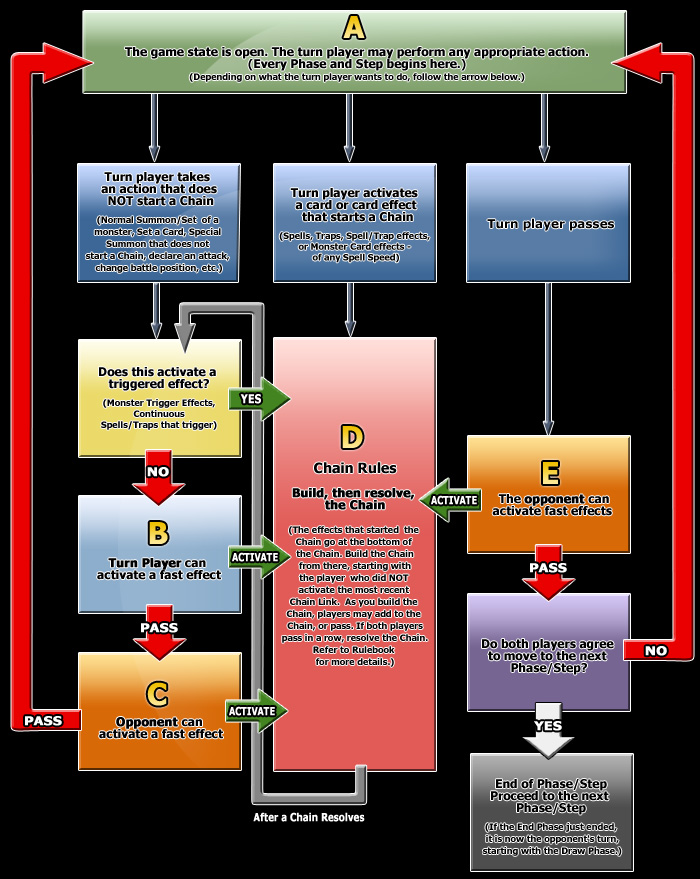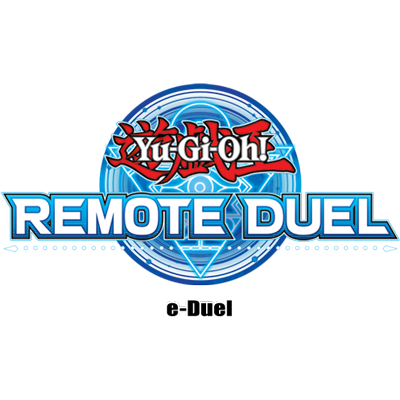Fast effects & Timing
Fast effects are card activations and effects with a Spell Speed of 2 or higher, including monster Quick Effects, Quick-Play Spell Cards, and Trap Cards (which includes both activating Trap Cards, and activating the effects of things like Continuous Trap Cards).
Fast effects can be activated by either player – even during their opponent’s turn, as long as the conditions are appropriate. When both players want to activate fast effects at the same time, they are placed on a Chain (see pages 38-41 of the v8.0 rulebook).
Sometimes, it can make a big difference WHO places their fast effect on the Chain first. This guide will help you figure out who, at any point in time, has the chance to activate the next fast effect (in other words, who gets to “go next”).
Usually, the turn player has the chance to “go next” and activate the next fast effect.
However, during a Chain, the chance to go next passes back and forth between players. (Chain rules: see pages 38-41 of the v8.0 rulebook.)
Also, if the turn player doesn’t wish to take any actions, and instead wants to move along in the turn (for example, to the next Step or Phase), the opponent has an opportunity to go next, and activate a fast effect, before the turn proceeds.
Follow the chart at the bottom to see which player can “go next” regarding fast effects.
Turn Player Actions
Each Phase and Step starts with the turn player in box A of the chart listed below. This is when the game state is “open”, meaning the turn player has complete freedom of action.
Many actions can ONLY be performed when the game state is open (when you’re in box A). Examples:
- Normal Summon (including Tribute Summon)
- Set a card
- Perform a Special Summon that does not start a Chain (including Xyz Summon, Synchro Summon)
- Change a monster’s Battle Position
- Attempt to move to the next Phase/Step
- Draw a card for your normal draw during the Draw Phase
- Declare an attack
- Activate an Ignition Effect
- Activate a Spell Speed 1 Spell Card
If the game state is “open”, the turn player may perform any of the above actions that is appropriate. They can also choose to activate a fast effect, if they wish.
When Is the Game State No Longer “Open”?
Whenever either player performs an action, the game state is no longer open.
How Do I Make the Game State “Open” Again?
Basically, when nothing is going on, and neither player wishes to do anything, the game state goes back to being “open”.
Technically, this means:
- IF the Turn Player has the chance to activate the next fast effect
- AND the turn player passes to the opponent
- AND the opponent then passes back
- AND no Chain is currently being formed
…then the game state is open again.
How Does the Turn Move to the Next Phase or Step?
If the game state is open, and the turn player chooses not to do anything, and the opponent waives the chance to activate a fast effect, and both players agree to have the turn proceed, then you move to the next Phase or Step.
| Status | Are we now in a Chain? | Who has the next opportunity to activate the next fast effect? (Who "goes next"?) | Where are we on the chart? | |
| The game state is open. The turn player gets to take the next action, and can take any action that is appropriate for that phase/step. | No | Turn Player | A | |
| After an action that does NOT start a Chain (Normal Summon/Set of a monster, Set a Card, Special Summon that does not start a Chain, declare an attack, change battle position, etc.) |
If there is an effect that is triggered. | Yes | The player who did NOT activate the last effect on the Chain. (Follow the normal Chain rules.) | D |
| If there is no effect that can be triggered. | No | Turn Player | B | |
| If the Turn Player passes. | No | Opponent | C | |
| Turn player activates a card or card effect (Spells, Traps, Spell/Trap effects, or Monster Card effects – of any Spell Speed) |
Yes | The player who did NOT activate the effect. (Follow the normal Chain rules.) | D | |
| After a Chain resolves | If there is an effect that is triggered. | Yes | The player who did NOT activate the last effect on the Chain. (Follow the normal Chain rules.) | D |
| If there is no effect that can be triggered. | No | Turn Player | B | |
| If the Turn Player passes. | No | Opponent | C | |
| Turn player passes | No | Opponent | E | |



